| کد مقاله | کد نشریه | سال انتشار | مقاله انگلیسی | نسخه تمام متن |
|---|---|---|---|---|
| 8347976 | 1541708 | 2015 | 8 صفحه PDF | دانلود رایگان |
عنوان انگلیسی مقاله ISI
Pancreatic polypeptide responses to isoglycemic oral and intravenous glucose in humans with and without intact vagal innervation
ترجمه فارسی عنوان
پاسخ های پلی پپتیدی پانکراس به گلوکز خوراکی و داخل وریدی ایگولیسمی در انسان با و بدون استنشاق بی حرکتی
دانلود مقاله + سفارش ترجمه
دانلود مقاله ISI انگلیسی
رایگان برای ایرانیان
کلمات کلیدی
پالپپتید پانکراس، انسان، واگوتومی، عصب واگ، گلوکز،
موضوعات مرتبط
علوم زیستی و بیوفناوری
بیوشیمی، ژنتیک و زیست شناسی مولکولی
زیست شیمی
چکیده انگلیسی
Secretion of pancreatic polypeptide (PP) from the pancreatic PP cells is controlled partly by vagal mechanisms. Release is stimulated by cephalic stimulation and enteral but not parenteral nutrients. Ambient glucose levels modulate circulating PP levels as hypoglycemia stimulates while hyperglycemia inhibits secretion. The glucose sensing mechanism has yet to be determined but may involve a vagal pathway. To investigate the role of enteral stimuli with or without intact vagal innervation, while controlling for the glucose excursion caused by the OGTT, we measured PP plasma levels by an in-house radioimmunoassay in truncally vagotomized (n=15) and control individuals (n = 10). All participants were studied by a 50-g oral glucose tolerance test (OGTT) with or without dipeptidyl peptidase 4 (DPP-4) inhibition (DPP-4i) and a subsequent isoglycemic intravenous glucose infusion (IGII). We included measurements from the DPP-4i day to determine the potential effect of DPP-4-cleaved peptides on PP secretion. In both vagotomized and controls, oral glucose elicited PP secretion. In controls, but not in the vagotomized participants, intravenous glucose significantly inhibited PP secretion suggesting a vagal glucose sensing mechanism dependent on intact vagal innervation. DPP-4i did not alter PP secretion in either group.
ناشر
Database: Elsevier - ScienceDirect (ساینس دایرکت)
Journal: Peptides - Volume 71, September 2015, Pages 229-231
Journal: Peptides - Volume 71, September 2015, Pages 229-231
نویسندگان
Simon Veedfald, Astrid Plamboeck, Bolette Hartmann, Lars B. Svendsen, Tina Vilsbøll, Filip K. Knop, Jens J. Holst,
